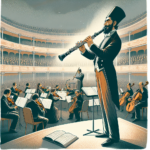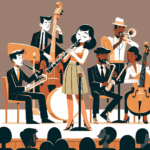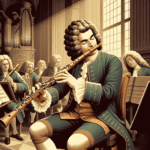Historical clarinet concert attire has evolved alongside music and society. The outfits worn by clarinetists have been just as diverse and captivating as the melodies they play, ranging from powdered wigs and embroidered coats to modern tuxedos and elegant gowns.
In the Baroque era, performers donned formal wear that reflected the grandeur of court performances. Male clarinetists sported elaborate waistcoats, knee-length breeches, and silk stockings. Women, with limited on-stage roles, wore large gowns decorated with lace and detailed embellishments, showcasing the opulence expected at high-society events.
The Classical Era: A Shift in Style
As music evolved into the Classical period, so did the fashion. Attire became somewhat less showy but maintained a refined, formal look. Men increasingly favored tailcoats, while women opted for more streamlined dresses. Clarinetists, now more prominent in orchestras and solo performances, followed these trends while captivating audiences with their musical skill.
| Era | Men's Attire | Women's Attire |
|---|---|---|
| Baroque | Elaborate waistcoats, knee-length breeches, silk stockings | Voluminous gowns with lace and intricate details |
| Classical | Tailcoats | More streamlined dresses |
| Romantic | Dark frock coats, cravats | Ornate dresses with dramatic colors and cuts |
| 20th Century | Tailcoats or tuxedos | Floor-length gowns or tailored suits |
The Romantic Period: Expressive Freedom
The Romantic period introduced a notable change in attire, highlighting individual expression and aligning with the increased creative freedom in musical composition. Men's formal wear, such as dark frock coats and cravats, radiated elegance. Women's dresses became more elaborate and striking in color and design, perfectly complementing the emotional depth of Romantic performances.
20th Century: Practicality Takes Center Stage
In the 20th century, comfort and functionality became key considerations. Male clarinetists often performed in tailcoats or tuxedos, while female performers could choose between floor-length gowns or tailored suits. These outfits provided better mobility for the increasingly complex musical pieces. During this time, professional ensembles, including those using Martin Freres clarinets, became known not only for their music but also for their timeless stage presence.
Modern Day: Blending Tradition with Contemporary Style
Today's concert settings still pay homage to earlier traditions. Contemporary clarinetists often blend historical styles with modern aesthetics, prioritizing both comfort and professionalism. While formal black remains popular, personal touches like patterned scarves or custom jackets allow performers to express their individuality while respecting their musical roots.
The Impact of Attire on Performance
Concert attire goes beyond mere appearance. A well-chosen outfit can boost confidence and improve performance posture. Experienced Martin Freres players often emphasize how paying attention to both instrument and attire details creates a memorable concert experience. Many believe that maintaining stage traditions keeps the spirit of clarinet performance alive, bridging the gap between the rich history and innovative present of music.
Conclusion
Whether you're drawn to the extravagant costumes of Baroque concerts or prefer the sleek look of modern performers, it's clear that historical clarinet concert attire plays a crucial role in celebrating the art of clarinet playing and enhancing the magic of live music. The evolution of performers' fashion is not just a side note to the music; it's an essential part of the overall musical experience.
Table of Contents
- The Classical Era: A Shift in Style
- The Romantic Period: Expressive Freedom
- 20th Century: Practicality Takes Center Stage
- Modern Day: Blending Tradition with Contemporary Style
- The Impact of Attire on Performance
- Conclusion








